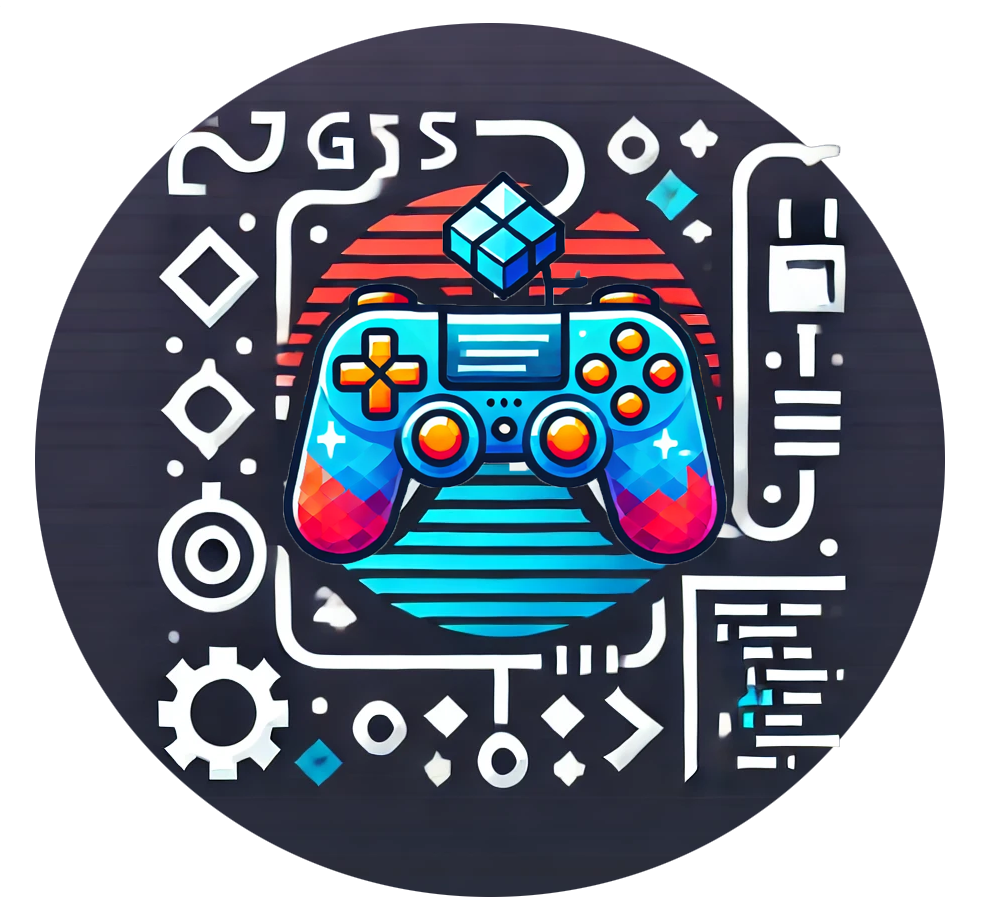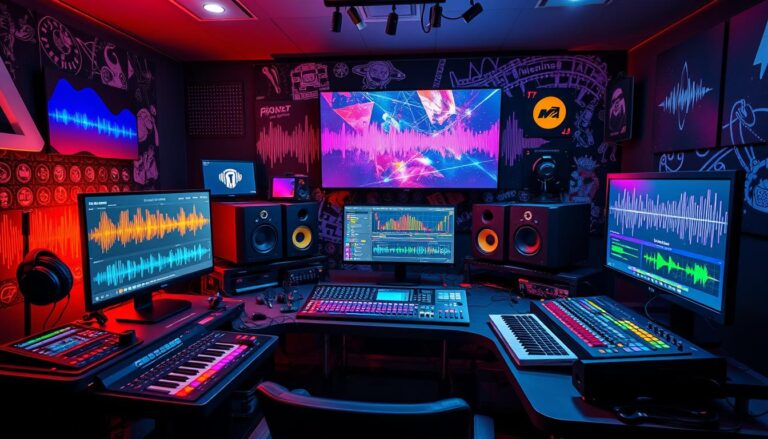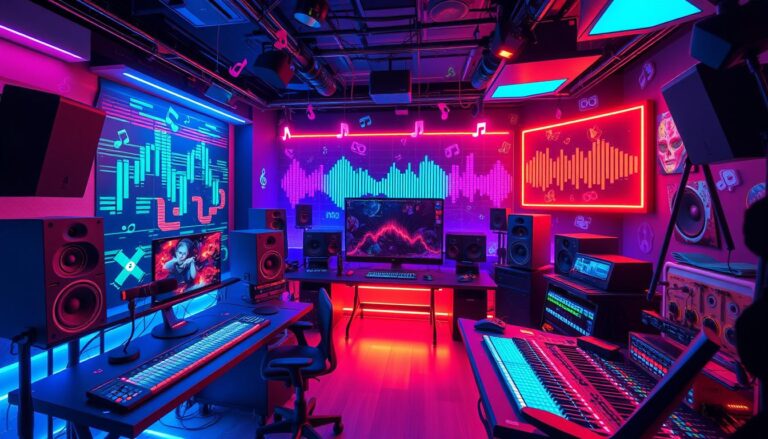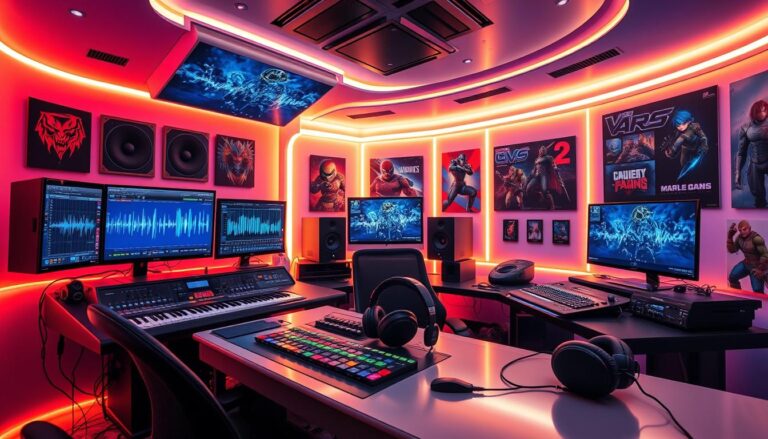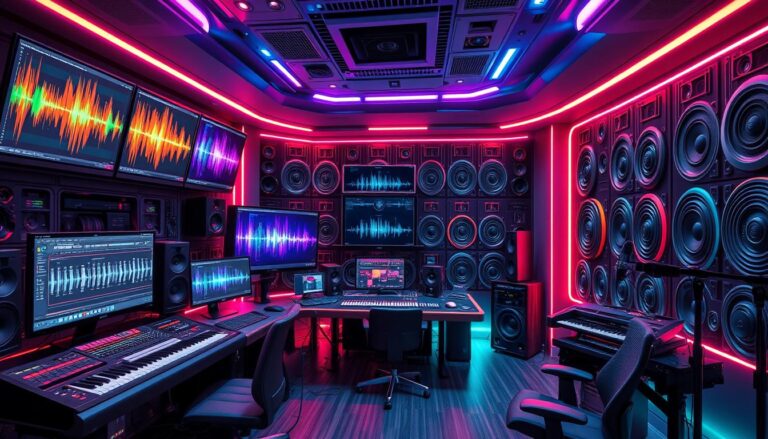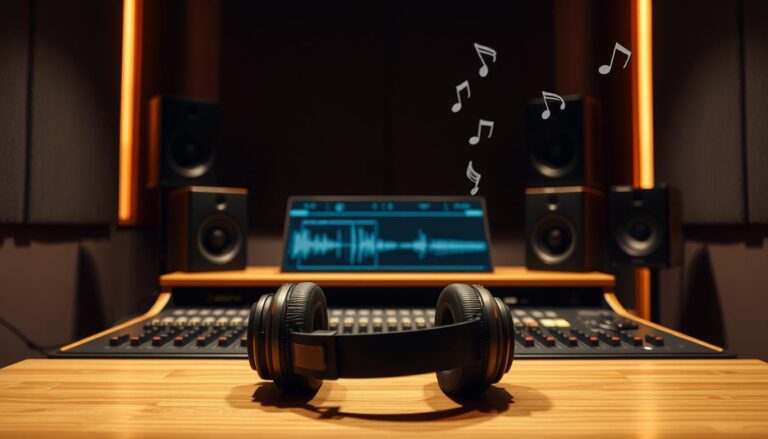How Do You Create Realistic Soundscapes for Games?
Making soundscapes for games is key in game sound design. It needs a deep understanding of game audio and its techniques. This includes making sound effects loop, adding dynamic sounds, and using audio middleware.
Creating soundscapes means thinking about both environmental and abstract sounds. Environmental sounds like ambient noise help set the scene. Abstract sounds, on the other hand, add emotions and tension.
Dynamic audio systems also play a big role. They change the game’s music and sounds based on what the player does. New tech like 3D spatial audio and AI soundscapes make games sound more real.
To make great soundscapes, you need technical skills, creativity, and a good grasp of game sound design. With these, game audio pros can make worlds that draw players in and tell stories through sound.
Understanding the Fundamentals of Game Sound Design and Audio Effects
Game sound design is key to making games feel real. It’s about creating an audio world that pulls players in. Sound designers mix environmental and abstract sounds to get the perfect feel.
Environmental vs Abstract Sound Elements
Environmental sounds, like wind or traffic, set the game’s scene. Abstract sounds, on the other hand, affect how players feel and add to the story.
The Role of Dynamic Audio Systems
Dynamic audio systems are vital in game sound design. They change sounds based on what the player does. This makes the audio more alive and engaging.
Core Components of Game Soundscapes
The heart of game soundscapes includes ambient sounds, spot effects, and dynamic changes. These elements work together to make a rich audio experience that boosts the game.
| Sound Design Criteria | Description |
|---|---|
| DX (Dialogue) | Dialogue, narration, and character voices |
| MX (Music) | Background music, themes, and musical cues |
| SFX (Sound Effects) | Spot effects, environmental sounds, and object-based sounds |
| FOL (Foley) | Realistic, synchronized sound effects based on on-screen actions |
| BG (Backgrounds) | Ambient, looping sounds that establish the game environment |
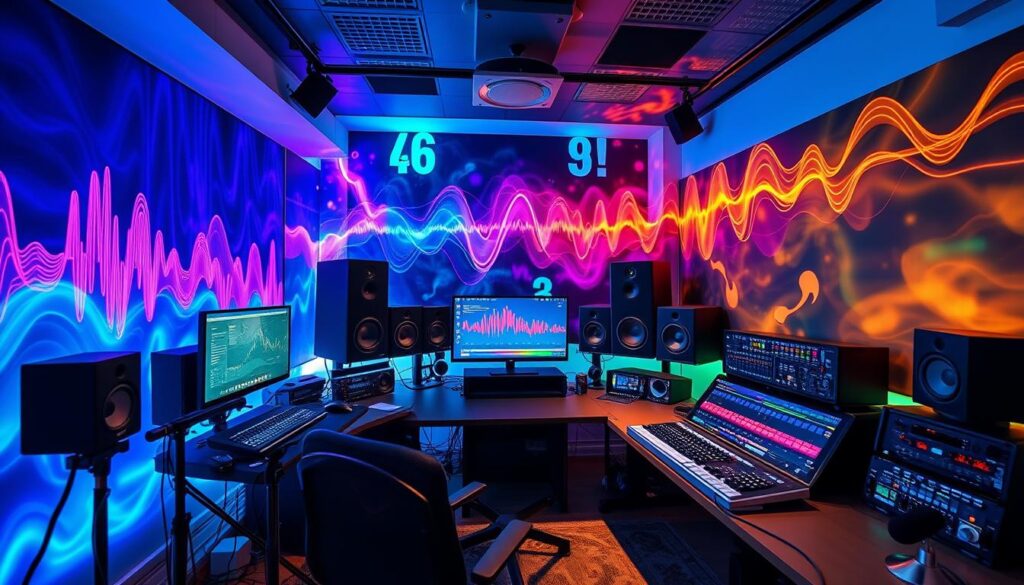
Understanding game sound design and audio effects is crucial. It helps sound designers craft immersive audio that draws players in and tells the game’s story.
Creating and Managing Ambient Sound Beds
Ambient sound beds are key to creating soundscapes in video games. They often include stereo loops like room tones, wind, or city hum. To make them, you need to record or find the right audio, edit out any distinct sounds, and loop it smoothly.
Using audio middleware helps control how these sounds change based on where the player is and what’s happening in the game. This makes the soundscape more immersive and interactive. With audio middleware, designers can mix the audio better and manage sound assets more effectively, improving the game’s atmosphere.
| Ambient Sound Bed Techniques | Benefits |
|---|---|
| Crossfading | Smooth transitions between loop segments |
| Zero Crossing Removal | Preventing audible clicks during looping |
| Audio Middleware Integration | Dynamic control over ambient sound behavior |
Mastering ambient sound beds is essential for game audio designers. It helps create a rich and engaging soundscape that pulls players into the game world. This is a critical part of audio design for a memorable and immersive gaming experience.

Implementing Dynamic Sound Elements and Effects
Creating a captivating game soundscape is more than just static sounds. It’s about making sounds that change with player actions and the environment. This interactive audio makes the game world feel real and engaging.
One-Shot Texture Sound Design
One-shot sounds, like animal calls or footsteps, are key to a detailed soundscape. Tools like FMOD’s Scatter Instrument make adding these interactive audio elements easy. This way, the game soundscape changes as the player moves and interacts with the environment.
Working with Audio Middleware
Audio middleware, like FMOD and Wwise, offers advanced game sound implementation features. These tools help manage sound effects like distance, panning, and more. This lets sound designers add environmental sounds that improve the player’s sense of space.
Sound Asset Management Solutions
Managing many sound assets is crucial for a full game soundscape. Sound designers need to think about file formats, channel setups, and memory use for smooth in-game performance. Using audio middleware tools helps organize and optimize sound libraries. This makes the game audio more immersive and responsive.
Advanced Techniques for Soundscape Variation
In game audio, making soundscapes that pull players in is key. It’s more than just sound design and effects. Developers use advanced methods to make the game’s sounds more varied and real.
One way is automation, which changes sounds based on how close the player is. Adjusting things like pitch and volume makes the game’s sounds more alive. As players move, the sounds change, making the game feel more real.
Another trick is pitch and volume randomization for sounds like footsteps. This makes the game feel more natural and less repetitive. It’s like the game world is breathing and moving with the player.
Adding layers to ambient sounds also makes the game world richer. Creating multi-layered ambiences that change with time or weather keeps the game fresh. It keeps players engaged in the virtual world.
Thinking about sound spatialization, day/night cycles, and weather adds even more realism. These elements make the game’s soundscape more dynamic and immersive. It’s a way to draw players into the game’s world.
By using these advanced techniques, game audio teams can create amazing soundscapes. They push the limits of sound synthesis, audio mixing, and immersive soundscapes. This makes the game world feel alive and ever-changing, drawing players in with sound.
Conclusion
Making realistic soundscapes for games needs a deep understanding of sound design, audio effects, and immersive audio. By learning about environmental and abstract sounds, dynamic audio systems, and game soundscapes, sound designers can make audio that pulls players in. This makes the game more fun and engaging.
Using dynamic sound elements, managing audio assets, and applying advanced techniques are key. Sound designers must keep up with new trends and technologies, like binaural recording and virtual reality audio. This helps them create soundscapes that are smooth and consistent.
The art of game sound design is all about solving problems, being creative, and loving video games. Sound designers use their skills to make soundscapes that take players on a journey. As games keep getting better, sound design will become even more important. It’s a vital part of making games that players will remember.
